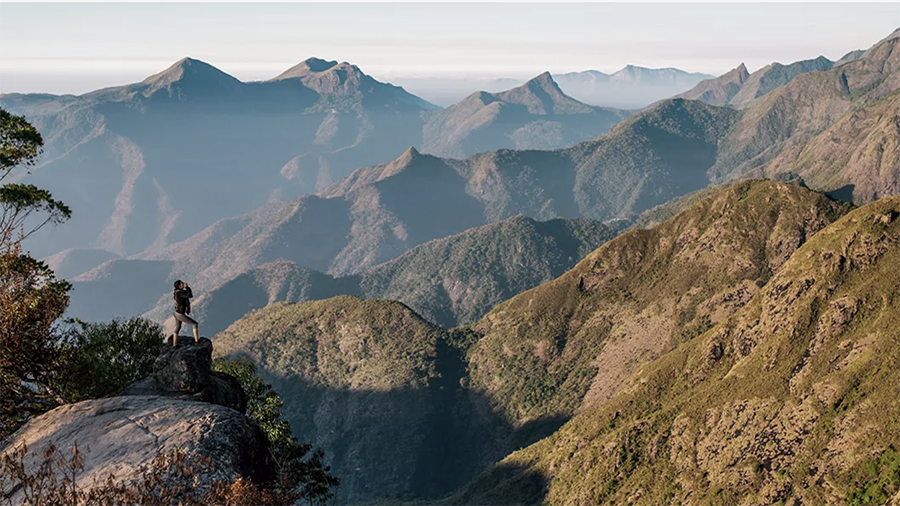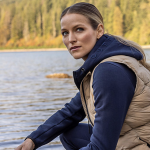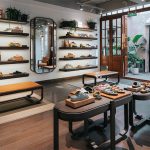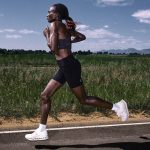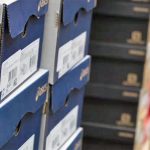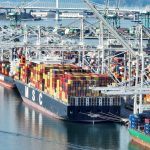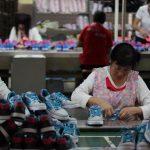Kent Ebersole, president of the Outdoor Industry Association (OIA), spoke with SGB Executive about the organization’s mission-driven focus, the challenges facing the outdoor industry beyond tariffs and revitalizing a national industry tradeshow.
Ebersole spent his early days in the outdoor industry with Rodale, Inc. and Active Interest Media, managing the business of outdoor media brands including Backpacker, Climbing, Ski, and Warren Miller. Prior to joining OIA as president in March 2023, following Lise Aangeenbrug’s resignation, he consulted for nonprofits and served on the Camber Outdoors Board of Directors for six years. Aangeenbrug became chief program officer at the National Park Foundation.
 SGB: Can you tell us about your career and how you came to work at OIA?
SGB: Can you tell us about your career and how you came to work at OIA?
Kent Ebersole: I started right out of college in advertising sales at the Chicago Tribune, and I just loved media — now we call it content — from a business perspective. Every day, going to work in the Tribune Tower was like the greatest day of my life. It was a job I loved. It was a company I loved. At that time, it was still one of the strongest media companies in America, with radio stations, television stations, etc. They owned the Cubs. They ran multiple newspapers. It was a fantastic time to be at a newspaper back then. But my personal love was the outdoors, whether running, biking, hiking, backpacking, climbing. I moved to New York City and got a job at Rodale, Inc., which was a privately held publishing company at the time and owned a bunch of magazines, including Men’s Health, Runner’s World, Bicycling and Backpacker. I worked for Backpacker and was able to combine my love for content with the outdoors. But it was also not just the outdoors; Rodale was a mission-driven company. We etched into our daily conversations that we were there to do great work for our consumers — our readers and subscribers. And if you do great work for them, they will pay for your product. And if they pay for your product, you can take that money, invest it in research, and learn more about them. And if you learn more about your customer, you can do great work. So we lived that cycle of leadership, and that’s where I combined my outdoor interests and a mission-driven mindset within content. Backpacker was one of the best jobs I ever had, and that lasted for over a decade.
SGB: What happened after Backpacker?
Ebersole: At some point, Backpacker was sold to Active Interest Media, and I went to work there. We built a collection of outdoor brands and tried to consolidate back-office functions and to leverage what we were good at — content. It was a difficult time in the magazine world at that point. Mostly, what I learned over that time is that acquiring other brands to make a collection of brands can make sense on a spreadsheet, but that doesn’t always mean it’s that easy to make it work in person. Cultural collaboration is probably the greatest challenge in that acquisition process. You’ve got a climbing culture coming together with a skiing culture and a hiking culture, and the people that built those brands were steeped in those cultures. When you bring them together, you must account for that. And it was a great lesson we learned. Ultimately, those brands were all sold to Outside, and I went my separate way. I did all kinds of consulting work for a couple of years and then, eventually, in 2022, came back directly to the outdoor industry as interim president and, eventually, permanent president at Outdoor Industry Association, which is kind of like a dream job for me at this point in my career.
SGB: You took over as OIA’s interim president in August 2022, amidst the pandemic, supply chain bottlenecks and challenges with the Outdoor Retailer trade show. What was it like in your beginning months?
Ebersole: I want to make sure to give credit to Lise Aangeenbrug, my predecessor. She was executive director before me and guided this organization through the pandemic, not me. She did the heavy lifting in the pandemic and did a fantastic job. It was a thankless job, and it was really difficult because of all the things mentioned, but she dealt with that head-on. By the time I got here, most, if not all, of those issues she had tackled head-on, and she had set up the organization to be successful. When I got here, we had to deal with the post-pandemic issues, including the fact that the trade show was changing significantly because of the pandemic.
SGB: OIA ended its partnership with Emerald Expositions and the Outdoor Retailer show in July 2024 after 30 years. Did the pandemic cause the separation?
Ebersole: I’m not a trade show expert. I do love events. But I’m not a trade show expert, so I have to be careful I don’t act like an expert here. When you talk to people who manage trade shows, they say that shows change and evolve all the time to meet the needs of the industry, the economics, or whatever it is. I started going to Outdoor Retailer when it was in Reno, then Salt Lake, then Denver, and then back to Salt Lake. I don’t think I missed a single trade show in those 20 years, and going to that trade show twice a year helped me build a career. By 2016 or 2017, you could visually see the trade show changing. I don’t know what the numbers were, but brands were consolidating their booth space, using it for different purposes, changing what they brought, how many people attended, what their planned lift was, etc. I think that was a response to the return on investment. So that world was changing way back in 2016 or 2017 — about nine years ago. The pandemic didn’t kill any trade shows in America, but what it did was draw increased attention to the existing issues.
SGB: What’s your stance on what a national show should be or whether the industry needs one?
Ebersole: We are a member-led organization, which means my responsibility and my accountability is to the OIA members. The first thing that I would say is that it doesn’t matter what I think; it matters what retailers and brands think. That’s why we’re constantly asking them, sussing out what they think; we created a task force on this very subject. So the question is: What do those retailers and brands care about in a show? Part of the answer is that if you can deliver on value to retailers, then you have something. That’s where it starts. If you can do that, brands will show up. Some may think if you get the brands, the retailers show, but I think it’s retail driven.
With that, I would tell you, Grassroots Outdoor Alliance’s Connect show has material value. It makes a difference; they do a fantastic job, and we need them in this space. Secondly, the regional shows have really high ROI for brands and retailers. The cost is low, and brands have people deployed there already. Those shows do a pretty darn good job of delivering on the needs for brands and retailers.
So when thinking about a national show, you start by asking, “What are the gaps that are missing here?” That could be the community aspect or a need for education and thought leadership events, and not all CEOs or executives can attend Connect or the regional shows. So, the industry has thought leadership events for the director level and above, practitioner events for individuals working in particular fields like sustainability or community events, and then there’s B2B and B2C. There may be more, but there’s actually a lot going on in the industry. Really, to me, this comes down to collaboration. If there’s strong collaboration, we’re not going to talk about dates anymore because we’ll work together to figure that out.
SGB: Is timing always the major hurdle?
Ebersole: The date question is the first thing that comes up, but it’s really not going to come up if the leaders of the shows collaborate and work together. But it’s more than just dates. It’s how do we work together so that we don’t tax the industry in having brands and retailers needing to travel to multiple places. And it’s also about delivering community and those education sessions on where we’re going in the future. I think that’s critical.
SGB: In October 2024, OIA formed a partnership with Diversified Communications and their Switchback show. Why did you partner with Diversified?
Ebersole: First, it’s the people. We knew when we met them the first time that it was just going to be a different conversation with this group of people. There’s not a single person I’ve met there who isn’t super professional and easy to work with. Second, they presented us with a really thoughtful plan. It’s not a group of people who overpromise and underdeliver. It’s a group that thinks things through and is comfortable with a strategic pace that might make other people nervous. And they limited the number of exhibitors for the spring show in Nashville. They capped it. I’m sure some brands wanted to buy booth space, but they wanted to make sure that if you’re a retailer and you come, we’re going to meet your expectations. They do plan to grow, but if you talk to them about fast growth, that’s not their plan. It’s thoughtful and sustainable growth. Third, it’s one of the most mission-driven companies I’ve ever met – reminds me so much of Rodale. And I think it’s critical because there’s something special about the outdoor industry. We’re really mission driven. We’re focused on impact. We’re focused on people. We’re focused on what it means at the end of the day. You can’t be a guide service guiding people on a rafting trip and not at the end of the day look back at your consumer and wonder, “Are they having fun? Am I delivering on their adventure?” But we all have that inside us, and so I think Diversified Communications has that in there, too.
SGB: What was the response to the inaugural Switchback Spring show? Any criticism?
Ebersole: Everybody’s going to comment about the timing, about the lunch, the dinner, the hotel, etc. But those things are pretty easy to deal with and work on. But there were not a lot of complaints on substantive issues. We heard a lot of great things. I think the education and the community events were highlights of the show, and we’re exploring ways we can improve on those areas for next year.
SGB: How are tariffs impacting the industry?
Ebersole: Tariffs just kind of suck the oxygen out of the room for all the other issues. We had a webinar on trade in the spring, and we met our Zoom capacity for the first time in our history. We never had to turn people away. The next day, as we were getting prepared to do a follow-up, everything changed, and that’s the nature of it. I think the real challenge is the uncertainty. No one’s ever come to me and said, “We can’t have tariffs ever.” Everybody who’s come to me has basically said, “I just want to eliminate the chaos.” Whether you’re a startup in this industry or you’re a large public brand, you build your company based on a strategy and a plan. When there’s chaos that you can’t control, it makes it harder to do your work.
SGB: What mitigation options is OIA pursuing?
Ebersole: We’re in Washington, D.C., fighting these tariffs with, without a doubt, some of the best trade lobbyists in the industry – Sorini, Samet & Associates. Ron Sorini, Megan Costello, Mattie Amagai, Jackson House – those four people are fighting every day on behalf of this industry, and they’re really good at what they do. So that’s number one. I also think it’s critical for the legislators and policymakers on the Hill to hear what the industry thinks across issues. When we have our Capitol Summit, or when we have write-ins or virtual calls, it makes a big difference when they hear an owner of a company in the state that they represent show up and say, “Hey, I have 250 employees in this city, and it’s critical that we try to address these issues.” We’re doing that regularly. And I’d like to stress that we’re nonpartisan. We work with both Democrats and Republicans, and we work successfully with both Democrats and Republicans. Generally, most Democrats and Republicans care about the outdoors. There are 181 million people actively participating in the outdoors, or 58 percent of the U.S. population. So, it’s not hard to find people who care about the outdoors and care about public policy or public lands. It’s just hard to get them to come together and work together right now to find solutions.
SGB: What about the public lands fight?
Ebersole: Again, it’s bipartisan. We have good supporters on both sides of the aisle, but from protecting public lands from sell-off to improving the visitor experience, it’s about making sure policy doesn’t go backwards in this difficult time. And when I say difficult time, I mean if you’re cutting those resources, we have to be thoughtful about how we cut those resources. National Park visitation has hit an all-time high. Are we going to cut the resources and not give visitors a good experience? And it’s not just national parks, it’s the state parks, too, but the national parks are the sexiest thing to think about. It’s also the Bureau of Land Management (BLM). It’s the wilderness areas. All of those require federal money for upkeep, so that’s a big issue for us. We’re in there fighting for that. We also have the push to rescind the Roadless Rule that prevents roadbuilding and logging on roughly 58 million acres of federal forest and wildlands to protect America’s backcountry. That’s coming up, and we’re fighting for it. There are a lot of issues that are out there that aren’t getting the publicity that they need to get because we continue to read a social media post about trade, and we think, “Oh, man, I’m producing in that country. What’s going to happen?” But all these issues are important.
SGB: The outdoor industry has been through a lot with the pandemic and supply chain bottlenecks. How is it performing now?
Ebersole: I would say it depends on who you ask. If it’s the person who owns the company and it’s privately held, you might get a different answer from them than from a shareholder for a public company. You’re going to get a different answer from the team members of those companies. I go back to retail and the retail experience, whether online or brick-and-mortar, because all those experiences matter to the consumer. As I mentioned earlier, there are 181 million participants in the outdoor industry. That’s more than ever. My challenge to people in this industry is to go to a retail store or buy online and experience paying full price, because that will tell you quickly how the industry is these days. I just purchased some apparel from Toad&Co, and you feel like you are a member of a special club when you buy from them. They do a fantastic job of focusing on the user experience and adding value, which is critical. I also recently went to an outdoor retailer in the Midwest — Rusted Moon Outfitters in Indianapolis. If you walk in there, you’d think you were in Durango, Colorado. It’s in a nondescript part of town, but it’s damn cool. I challenge anybody who’s in this industry to walk in and not walk out without buying something at full price because the experience is spot-on. To summarize, I think the answer to the “How is the industry performing these days” question lies at the root of where the participant is purchasing, because if they’re not having a good experience with that retailer, whether online or in person, that’s what’s going to hurt the industry. So how are we performing? Go and look at a retail store and see what your experience is like.
Images courtesy Columbia Sportswear, OIA/Kent Ebersole

